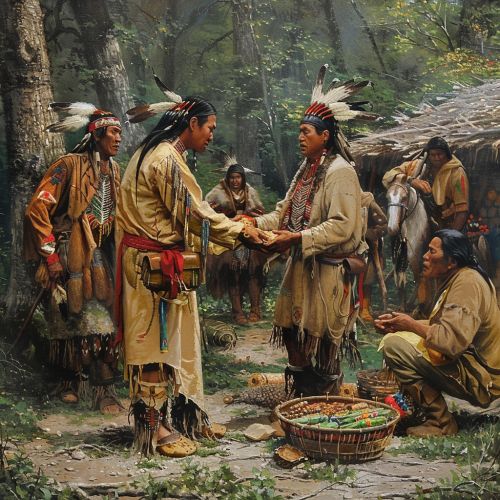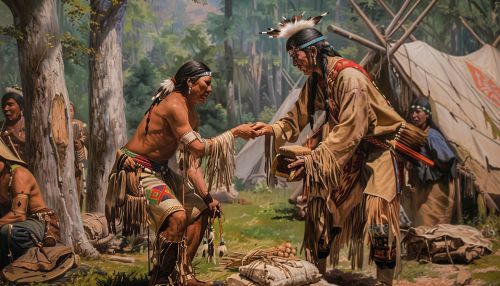Three Fires Confederacy
Overview
The Three Fires Confederacy, also known as the Council of Three Fires, was a long-standing alliance of three Native American tribes: the Ojibwe, the Odawa, and the Potawatomi. This confederation played a significant role in the history and culture of the Great Lakes region, particularly in the areas that are now Michigan, Wisconsin, and Ontario. The alliance was primarily formed for mutual protection, trade, and cultural exchange.
Historical Background
The origins of the Three Fires Confederacy date back to pre-colonial times. The Ojibwe, Odawa, and Potawatomi tribes share a common Algonquian language and cultural heritage. According to oral traditions, the confederacy was established to strengthen their collective power and ensure mutual support against common enemies, such as the Iroquois Confederacy.
Formation and Structure
The Three Fires Confederacy was not a centralized government but rather a loose alliance based on kinship and shared interests. Each tribe maintained its own leadership and autonomy but would come together for council meetings to discuss matters of common concern. The Ojibwe were considered the "older brother," the Odawa the "middle brother," and the Potawatomi the "younger brother." This hierarchical structure influenced their roles and responsibilities within the confederacy.
Cultural and Social Aspects
Language and Communication
The tribes of the Three Fires Confederacy spoke dialects of the Algonquian language family. While each tribe had its own dialect, they were mutually intelligible, facilitating communication and cooperation. The use of wampum belts was also common for recording treaties and agreements.
Spiritual Beliefs
Spirituality played a central role in the lives of the Three Fires tribes. They believed in a world inhabited by spirits and practiced various rituals to honor these spirits. The Midewiwin or Grand Medicine Society was an important spiritual and healing organization within the confederacy, particularly among the Ojibwe.
Social Structure
The social structure of the Three Fires tribes was clan-based. Each clan had specific roles and responsibilities within the tribe, such as hunting, fishing, and medicine. The clan system also played a crucial role in governance and decision-making processes.
Economic Activities
Trade Networks
The Three Fires Confederacy was part of an extensive trade network that spanned the Great Lakes region and beyond. They traded goods such as furs, corn, and fish with neighboring tribes and European settlers. The Odawa, in particular, were known as skilled traders and intermediaries.


Agriculture and Hunting
Agriculture was a significant part of the Three Fires' economy. They cultivated crops such as corn, beans, and squash, often referred to as the "Three Sisters." Hunting and fishing were also vital for their sustenance, with the Great Lakes providing abundant resources.
Political and Military Alliances
Relations with European Powers
The arrival of European settlers and traders in the Great Lakes region had a profound impact on the Three Fires Confederacy. They established alliances with French, British, and later American forces, often playing a strategic role in colonial conflicts such as the French and Indian War and the War of 1812.
Conflicts and Warfare
The Three Fires Confederacy engaged in various conflicts to protect their territories and interests. They were involved in the Beaver Wars against the Iroquois and later resisted American expansion during the Northwest Indian War. The confederacy's military strategies were often based on guerrilla tactics and intimate knowledge of the terrain.
Decline and Legacy
Impact of Colonization
The encroachment of European settlers and the subsequent loss of land had a devastating impact on the Three Fires Confederacy. Treaties such as the Treaty of Chicago led to significant land cessions and displacement of the tribes. The introduction of European diseases also caused a dramatic decline in their population.
Modern-Day Significance
Today, the legacy of the Three Fires Confederacy is preserved through cultural revitalization efforts and the recognition of tribal sovereignty. The Ojibwe, Odawa, and Potawatomi continue to maintain their cultural practices and languages, while also engaging in modern political and economic activities.
